Microeconomics: Analysis of Market Structure of Public Utility Service
VerifiedAdded on 2023/06/10
|8
|1750
|347
AI Summary
This assessment discusses the theoretical issues related to the market structure of public utility service, specifically water supply, in Australia. It analyzes the inefficiency, political drivers, and higher prices against competitive markets in the monopoly market structure. The position is derived on these issues and defended against possible arguments. The assessment concludes that microeconomics is applied to markets of products and services and deals with various economic and individual issues.
Contribute Materials
Your contribution can guide someone’s learning journey. Share your
documents today.
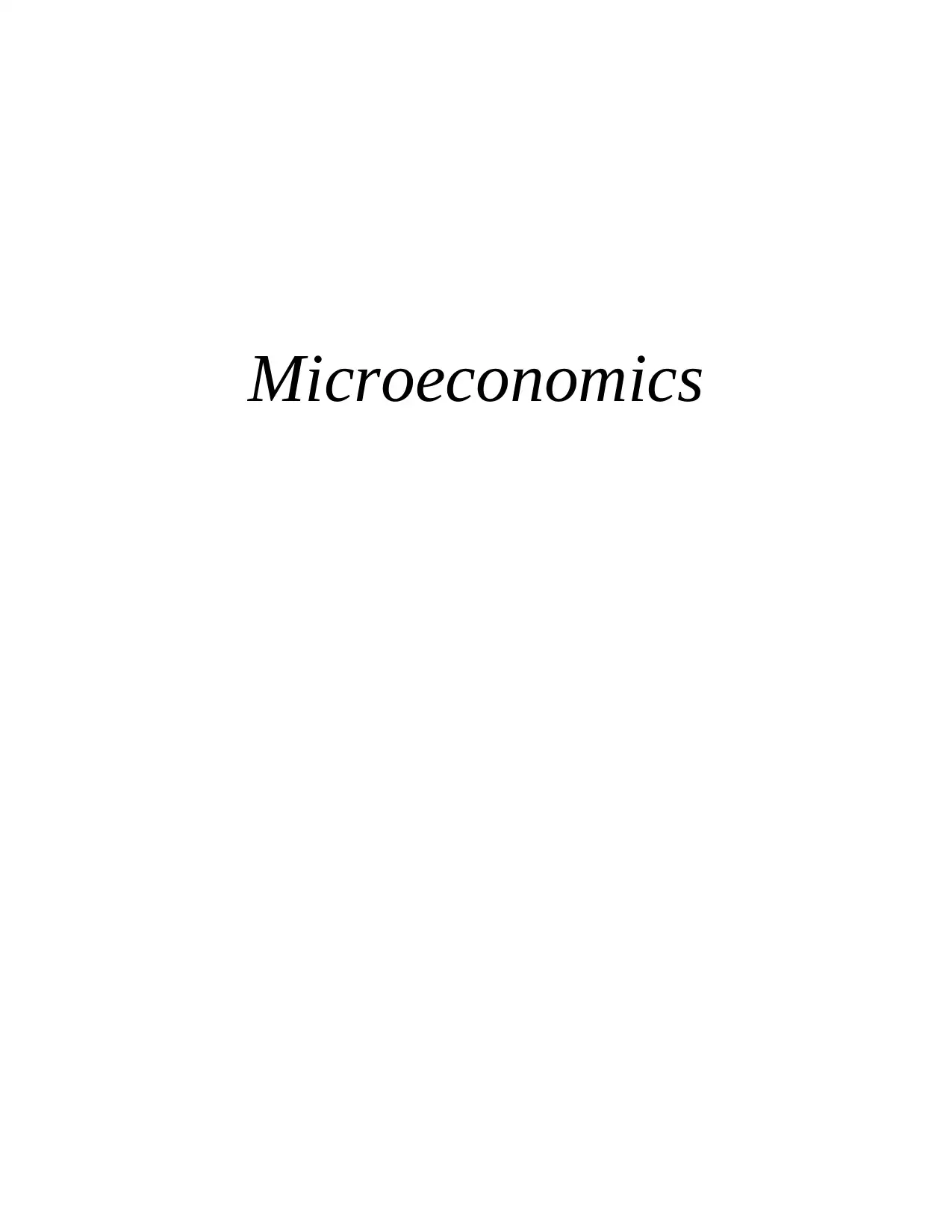
Microeconomics
Secure Best Marks with AI Grader
Need help grading? Try our AI Grader for instant feedback on your assignments.
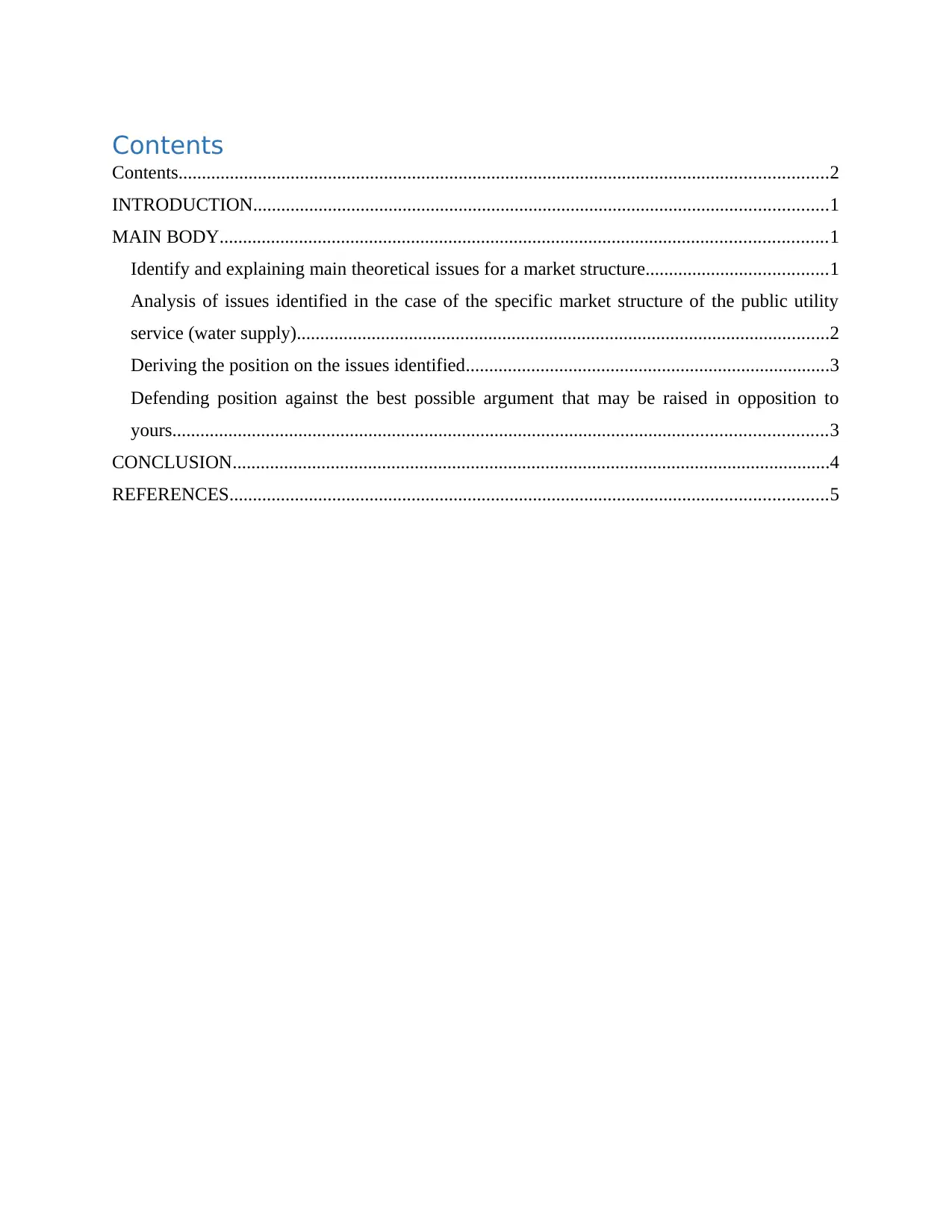
Contents
Contents...........................................................................................................................................2
INTRODUCTION...........................................................................................................................1
MAIN BODY..................................................................................................................................1
Identify and explaining main theoretical issues for a market structure.......................................1
Analysis of issues identified in the case of the specific market structure of the public utility
service (water supply)..................................................................................................................2
Deriving the position on the issues identified..............................................................................3
Defending position against the best possible argument that may be raised in opposition to
yours............................................................................................................................................3
CONCLUSION................................................................................................................................4
REFERENCES................................................................................................................................5
Contents...........................................................................................................................................2
INTRODUCTION...........................................................................................................................1
MAIN BODY..................................................................................................................................1
Identify and explaining main theoretical issues for a market structure.......................................1
Analysis of issues identified in the case of the specific market structure of the public utility
service (water supply)..................................................................................................................2
Deriving the position on the issues identified..............................................................................3
Defending position against the best possible argument that may be raised in opposition to
yours............................................................................................................................................3
CONCLUSION................................................................................................................................4
REFERENCES................................................................................................................................5

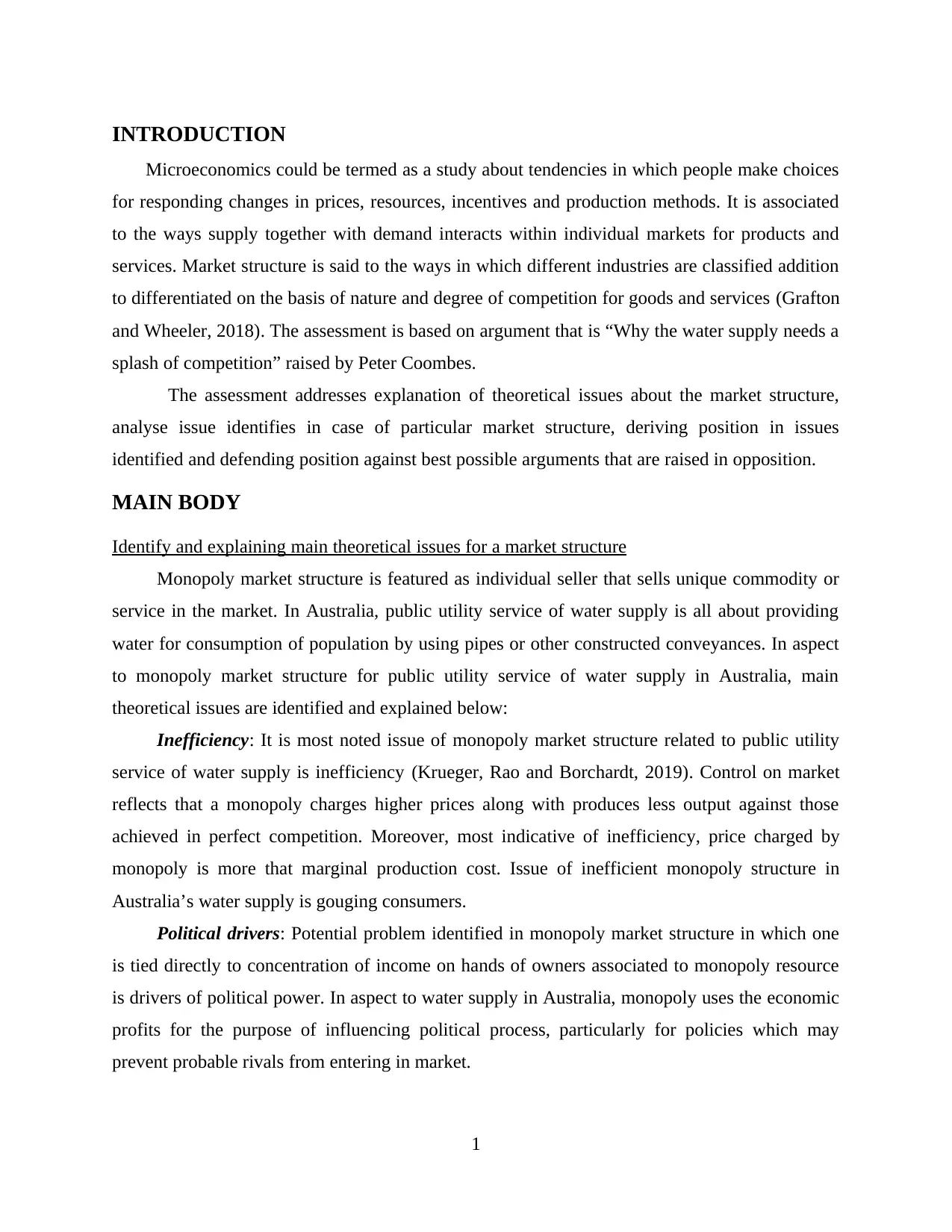
INTRODUCTION
Microeconomics could be termed as a study about tendencies in which people make choices
for responding changes in prices, resources, incentives and production methods. It is associated
to the ways supply together with demand interacts within individual markets for products and
services. Market structure is said to the ways in which different industries are classified addition
to differentiated on the basis of nature and degree of competition for goods and services (Grafton
and Wheeler, 2018). The assessment is based on argument that is “Why the water supply needs a
splash of competition” raised by Peter Coombes.
The assessment addresses explanation of theoretical issues about the market structure,
analyse issue identifies in case of particular market structure, deriving position in issues
identified and defending position against best possible arguments that are raised in opposition.
MAIN BODY
Identify and explaining main theoretical issues for a market structure
Monopoly market structure is featured as individual seller that sells unique commodity or
service in the market. In Australia, public utility service of water supply is all about providing
water for consumption of population by using pipes or other constructed conveyances. In aspect
to monopoly market structure for public utility service of water supply in Australia, main
theoretical issues are identified and explained below:
Inefficiency: It is most noted issue of monopoly market structure related to public utility
service of water supply is inefficiency (Krueger, Rao and Borchardt, 2019). Control on market
reflects that a monopoly charges higher prices along with produces less output against those
achieved in perfect competition. Moreover, most indicative of inefficiency, price charged by
monopoly is more that marginal production cost. Issue of inefficient monopoly structure in
Australia’s water supply is gouging consumers.
Political drivers: Potential problem identified in monopoly market structure in which one
is tied directly to concentration of income on hands of owners associated to monopoly resource
is drivers of political power. In aspect to water supply in Australia, monopoly uses the economic
profits for the purpose of influencing political process, particularly for policies which may
prevent probable rivals from entering in market.
1
Microeconomics could be termed as a study about tendencies in which people make choices
for responding changes in prices, resources, incentives and production methods. It is associated
to the ways supply together with demand interacts within individual markets for products and
services. Market structure is said to the ways in which different industries are classified addition
to differentiated on the basis of nature and degree of competition for goods and services (Grafton
and Wheeler, 2018). The assessment is based on argument that is “Why the water supply needs a
splash of competition” raised by Peter Coombes.
The assessment addresses explanation of theoretical issues about the market structure,
analyse issue identifies in case of particular market structure, deriving position in issues
identified and defending position against best possible arguments that are raised in opposition.
MAIN BODY
Identify and explaining main theoretical issues for a market structure
Monopoly market structure is featured as individual seller that sells unique commodity or
service in the market. In Australia, public utility service of water supply is all about providing
water for consumption of population by using pipes or other constructed conveyances. In aspect
to monopoly market structure for public utility service of water supply in Australia, main
theoretical issues are identified and explained below:
Inefficiency: It is most noted issue of monopoly market structure related to public utility
service of water supply is inefficiency (Krueger, Rao and Borchardt, 2019). Control on market
reflects that a monopoly charges higher prices along with produces less output against those
achieved in perfect competition. Moreover, most indicative of inefficiency, price charged by
monopoly is more that marginal production cost. Issue of inefficient monopoly structure in
Australia’s water supply is gouging consumers.
Political drivers: Potential problem identified in monopoly market structure in which one
is tied directly to concentration of income on hands of owners associated to monopoly resource
is drivers of political power. In aspect to water supply in Australia, monopoly uses the economic
profits for the purpose of influencing political process, particularly for policies which may
prevent probable rivals from entering in market.
1
Secure Best Marks with AI Grader
Need help grading? Try our AI Grader for instant feedback on your assignments.
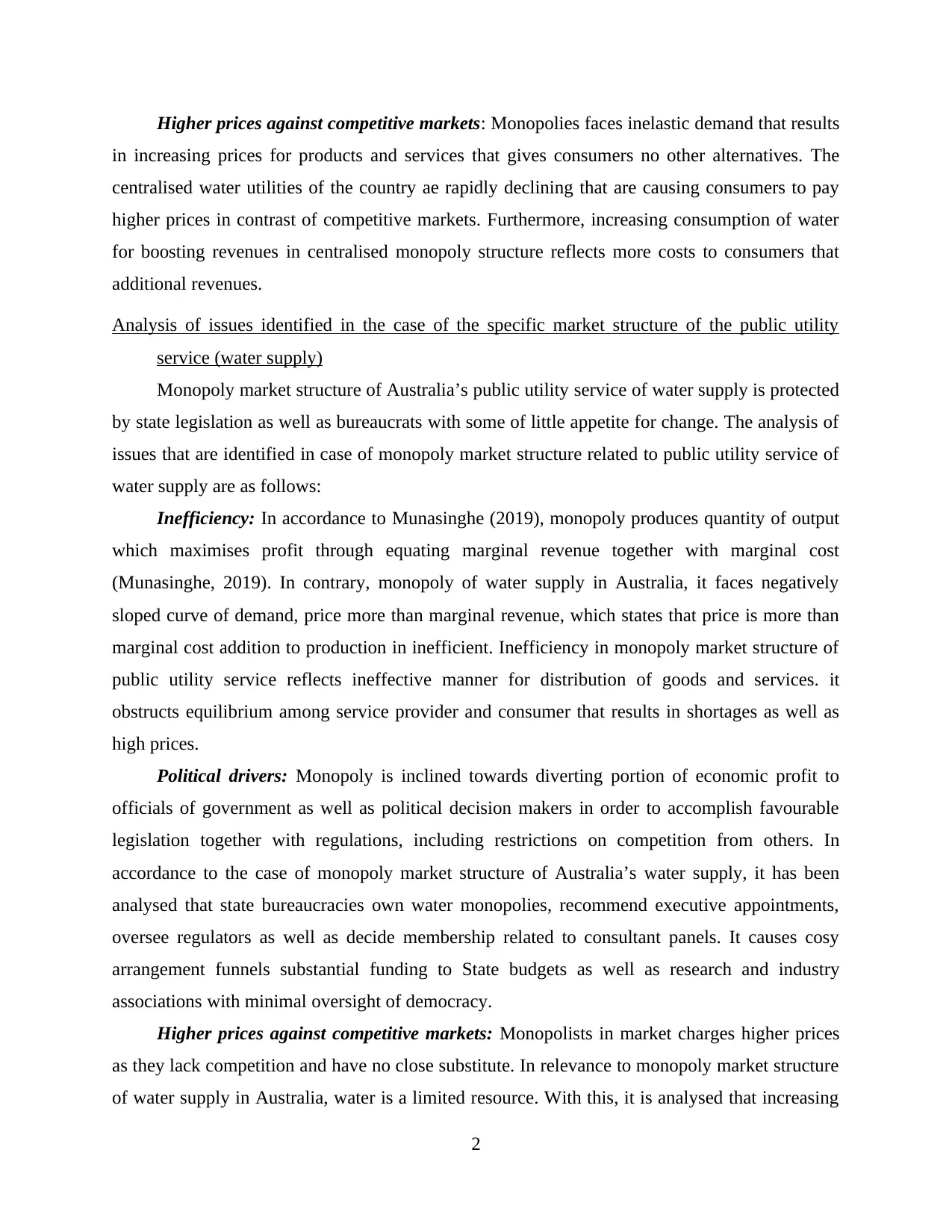
Higher prices against competitive markets: Monopolies faces inelastic demand that results
in increasing prices for products and services that gives consumers no other alternatives. The
centralised water utilities of the country ae rapidly declining that are causing consumers to pay
higher prices in contrast of competitive markets. Furthermore, increasing consumption of water
for boosting revenues in centralised monopoly structure reflects more costs to consumers that
additional revenues.
Analysis of issues identified in the case of the specific market structure of the public utility
service (water supply)
Monopoly market structure of Australia’s public utility service of water supply is protected
by state legislation as well as bureaucrats with some of little appetite for change. The analysis of
issues that are identified in case of monopoly market structure related to public utility service of
water supply are as follows:
Inefficiency: In accordance to Munasinghe (2019), monopoly produces quantity of output
which maximises profit through equating marginal revenue together with marginal cost
(Munasinghe, 2019). In contrary, monopoly of water supply in Australia, it faces negatively
sloped curve of demand, price more than marginal revenue, which states that price is more than
marginal cost addition to production in inefficient. Inefficiency in monopoly market structure of
public utility service reflects ineffective manner for distribution of goods and services. it
obstructs equilibrium among service provider and consumer that results in shortages as well as
high prices.
Political drivers: Monopoly is inclined towards diverting portion of economic profit to
officials of government as well as political decision makers in order to accomplish favourable
legislation together with regulations, including restrictions on competition from others. In
accordance to the case of monopoly market structure of Australia’s water supply, it has been
analysed that state bureaucracies own water monopolies, recommend executive appointments,
oversee regulators as well as decide membership related to consultant panels. It causes cosy
arrangement funnels substantial funding to State budgets as well as research and industry
associations with minimal oversight of democracy.
Higher prices against competitive markets: Monopolists in market charges higher prices
as they lack competition and have no close substitute. In relevance to monopoly market structure
of water supply in Australia, water is a limited resource. With this, it is analysed that increasing
2
in increasing prices for products and services that gives consumers no other alternatives. The
centralised water utilities of the country ae rapidly declining that are causing consumers to pay
higher prices in contrast of competitive markets. Furthermore, increasing consumption of water
for boosting revenues in centralised monopoly structure reflects more costs to consumers that
additional revenues.
Analysis of issues identified in the case of the specific market structure of the public utility
service (water supply)
Monopoly market structure of Australia’s public utility service of water supply is protected
by state legislation as well as bureaucrats with some of little appetite for change. The analysis of
issues that are identified in case of monopoly market structure related to public utility service of
water supply are as follows:
Inefficiency: In accordance to Munasinghe (2019), monopoly produces quantity of output
which maximises profit through equating marginal revenue together with marginal cost
(Munasinghe, 2019). In contrary, monopoly of water supply in Australia, it faces negatively
sloped curve of demand, price more than marginal revenue, which states that price is more than
marginal cost addition to production in inefficient. Inefficiency in monopoly market structure of
public utility service reflects ineffective manner for distribution of goods and services. it
obstructs equilibrium among service provider and consumer that results in shortages as well as
high prices.
Political drivers: Monopoly is inclined towards diverting portion of economic profit to
officials of government as well as political decision makers in order to accomplish favourable
legislation together with regulations, including restrictions on competition from others. In
accordance to the case of monopoly market structure of Australia’s water supply, it has been
analysed that state bureaucracies own water monopolies, recommend executive appointments,
oversee regulators as well as decide membership related to consultant panels. It causes cosy
arrangement funnels substantial funding to State budgets as well as research and industry
associations with minimal oversight of democracy.
Higher prices against competitive markets: Monopolists in market charges higher prices
as they lack competition and have no close substitute. In relevance to monopoly market structure
of water supply in Australia, water is a limited resource. With this, it is analysed that increasing
2
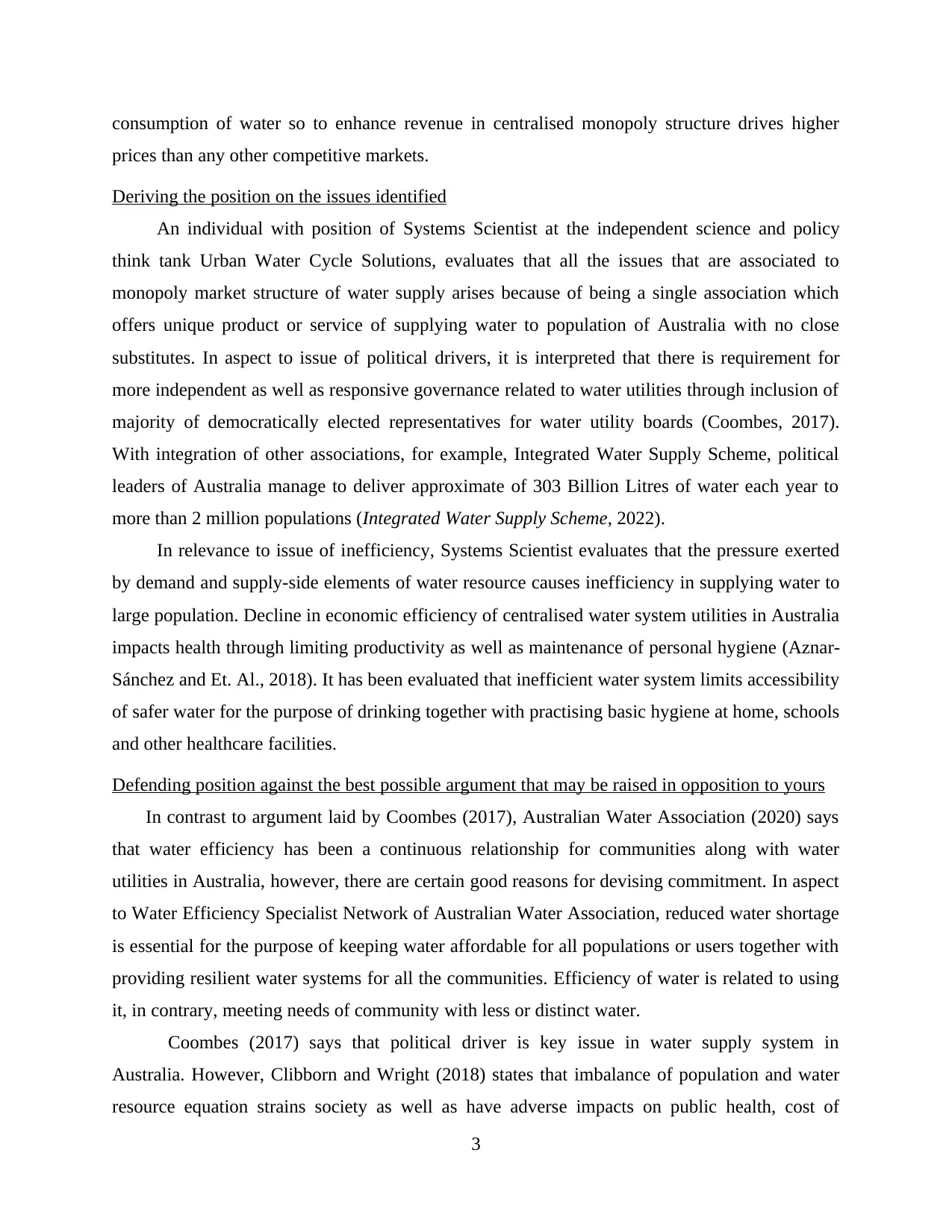
consumption of water so to enhance revenue in centralised monopoly structure drives higher
prices than any other competitive markets.
Deriving the position on the issues identified
An individual with position of Systems Scientist at the independent science and policy
think tank Urban Water Cycle Solutions, evaluates that all the issues that are associated to
monopoly market structure of water supply arises because of being a single association which
offers unique product or service of supplying water to population of Australia with no close
substitutes. In aspect to issue of political drivers, it is interpreted that there is requirement for
more independent as well as responsive governance related to water utilities through inclusion of
majority of democratically elected representatives for water utility boards (Coombes, 2017).
With integration of other associations, for example, Integrated Water Supply Scheme, political
leaders of Australia manage to deliver approximate of 303 Billion Litres of water each year to
more than 2 million populations (Integrated Water Supply Scheme, 2022).
In relevance to issue of inefficiency, Systems Scientist evaluates that the pressure exerted
by demand and supply-side elements of water resource causes inefficiency in supplying water to
large population. Decline in economic efficiency of centralised water system utilities in Australia
impacts health through limiting productivity as well as maintenance of personal hygiene (Aznar-
Sánchez and Et. Al., 2018). It has been evaluated that inefficient water system limits accessibility
of safer water for the purpose of drinking together with practising basic hygiene at home, schools
and other healthcare facilities.
Defending position against the best possible argument that may be raised in opposition to yours
In contrast to argument laid by Coombes (2017), Australian Water Association (2020) says
that water efficiency has been a continuous relationship for communities along with water
utilities in Australia, however, there are certain good reasons for devising commitment. In aspect
to Water Efficiency Specialist Network of Australian Water Association, reduced water shortage
is essential for the purpose of keeping water affordable for all populations or users together with
providing resilient water systems for all the communities. Efficiency of water is related to using
it, in contrary, meeting needs of community with less or distinct water.
Coombes (2017) says that political driver is key issue in water supply system in
Australia. However, Clibborn and Wright (2018) states that imbalance of population and water
resource equation strains society as well as have adverse impacts on public health, cost of
3
prices than any other competitive markets.
Deriving the position on the issues identified
An individual with position of Systems Scientist at the independent science and policy
think tank Urban Water Cycle Solutions, evaluates that all the issues that are associated to
monopoly market structure of water supply arises because of being a single association which
offers unique product or service of supplying water to population of Australia with no close
substitutes. In aspect to issue of political drivers, it is interpreted that there is requirement for
more independent as well as responsive governance related to water utilities through inclusion of
majority of democratically elected representatives for water utility boards (Coombes, 2017).
With integration of other associations, for example, Integrated Water Supply Scheme, political
leaders of Australia manage to deliver approximate of 303 Billion Litres of water each year to
more than 2 million populations (Integrated Water Supply Scheme, 2022).
In relevance to issue of inefficiency, Systems Scientist evaluates that the pressure exerted
by demand and supply-side elements of water resource causes inefficiency in supplying water to
large population. Decline in economic efficiency of centralised water system utilities in Australia
impacts health through limiting productivity as well as maintenance of personal hygiene (Aznar-
Sánchez and Et. Al., 2018). It has been evaluated that inefficient water system limits accessibility
of safer water for the purpose of drinking together with practising basic hygiene at home, schools
and other healthcare facilities.
Defending position against the best possible argument that may be raised in opposition to yours
In contrast to argument laid by Coombes (2017), Australian Water Association (2020) says
that water efficiency has been a continuous relationship for communities along with water
utilities in Australia, however, there are certain good reasons for devising commitment. In aspect
to Water Efficiency Specialist Network of Australian Water Association, reduced water shortage
is essential for the purpose of keeping water affordable for all populations or users together with
providing resilient water systems for all the communities. Efficiency of water is related to using
it, in contrary, meeting needs of community with less or distinct water.
Coombes (2017) says that political driver is key issue in water supply system in
Australia. However, Clibborn and Wright (2018) states that imbalance of population and water
resource equation strains society as well as have adverse impacts on public health, cost of
3
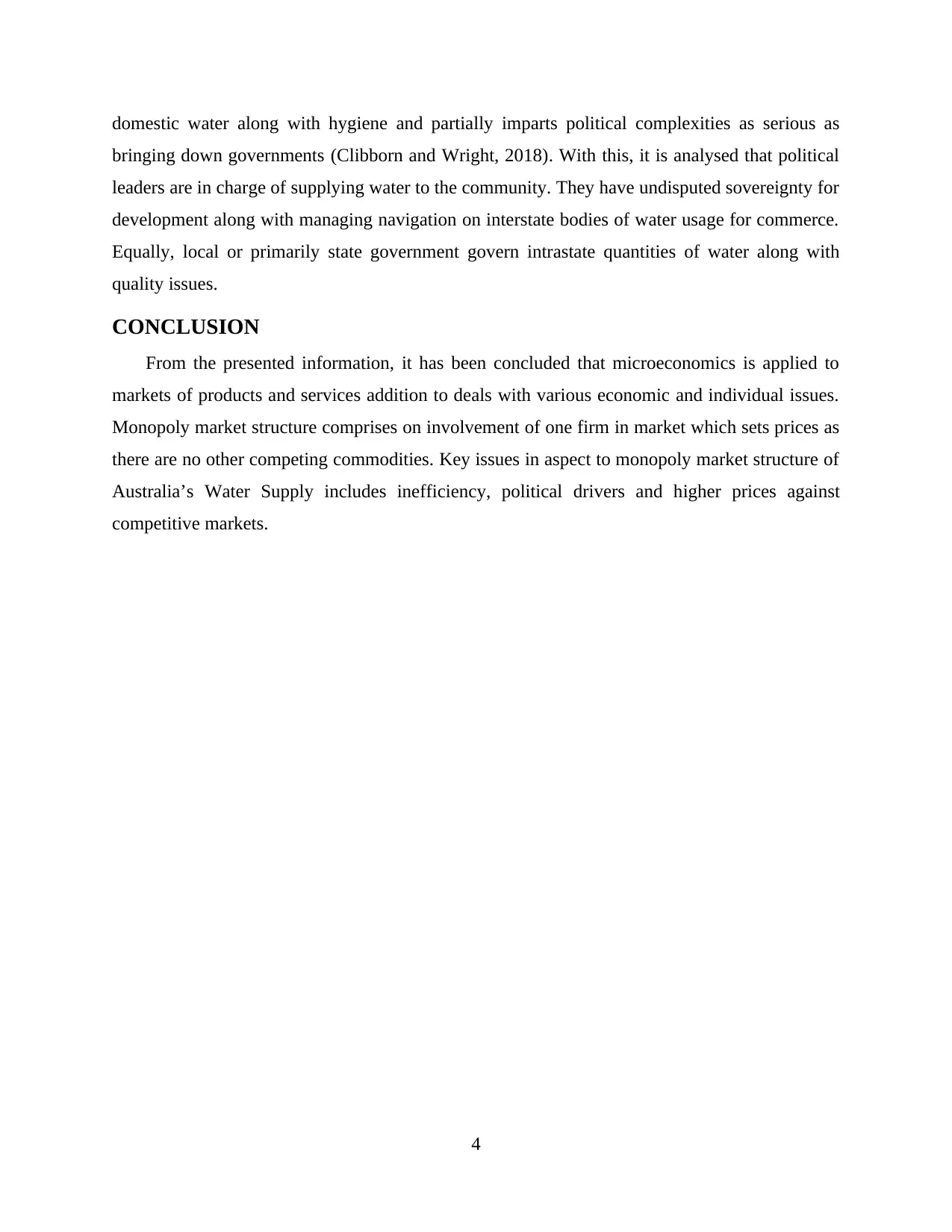
domestic water along with hygiene and partially imparts political complexities as serious as
bringing down governments (Clibborn and Wright, 2018). With this, it is analysed that political
leaders are in charge of supplying water to the community. They have undisputed sovereignty for
development along with managing navigation on interstate bodies of water usage for commerce.
Equally, local or primarily state government govern intrastate quantities of water along with
quality issues.
CONCLUSION
From the presented information, it has been concluded that microeconomics is applied to
markets of products and services addition to deals with various economic and individual issues.
Monopoly market structure comprises on involvement of one firm in market which sets prices as
there are no other competing commodities. Key issues in aspect to monopoly market structure of
Australia’s Water Supply includes inefficiency, political drivers and higher prices against
competitive markets.
4
bringing down governments (Clibborn and Wright, 2018). With this, it is analysed that political
leaders are in charge of supplying water to the community. They have undisputed sovereignty for
development along with managing navigation on interstate bodies of water usage for commerce.
Equally, local or primarily state government govern intrastate quantities of water along with
quality issues.
CONCLUSION
From the presented information, it has been concluded that microeconomics is applied to
markets of products and services addition to deals with various economic and individual issues.
Monopoly market structure comprises on involvement of one firm in market which sets prices as
there are no other competing commodities. Key issues in aspect to monopoly market structure of
Australia’s Water Supply includes inefficiency, political drivers and higher prices against
competitive markets.
4
Paraphrase This Document
Need a fresh take? Get an instant paraphrase of this document with our AI Paraphraser
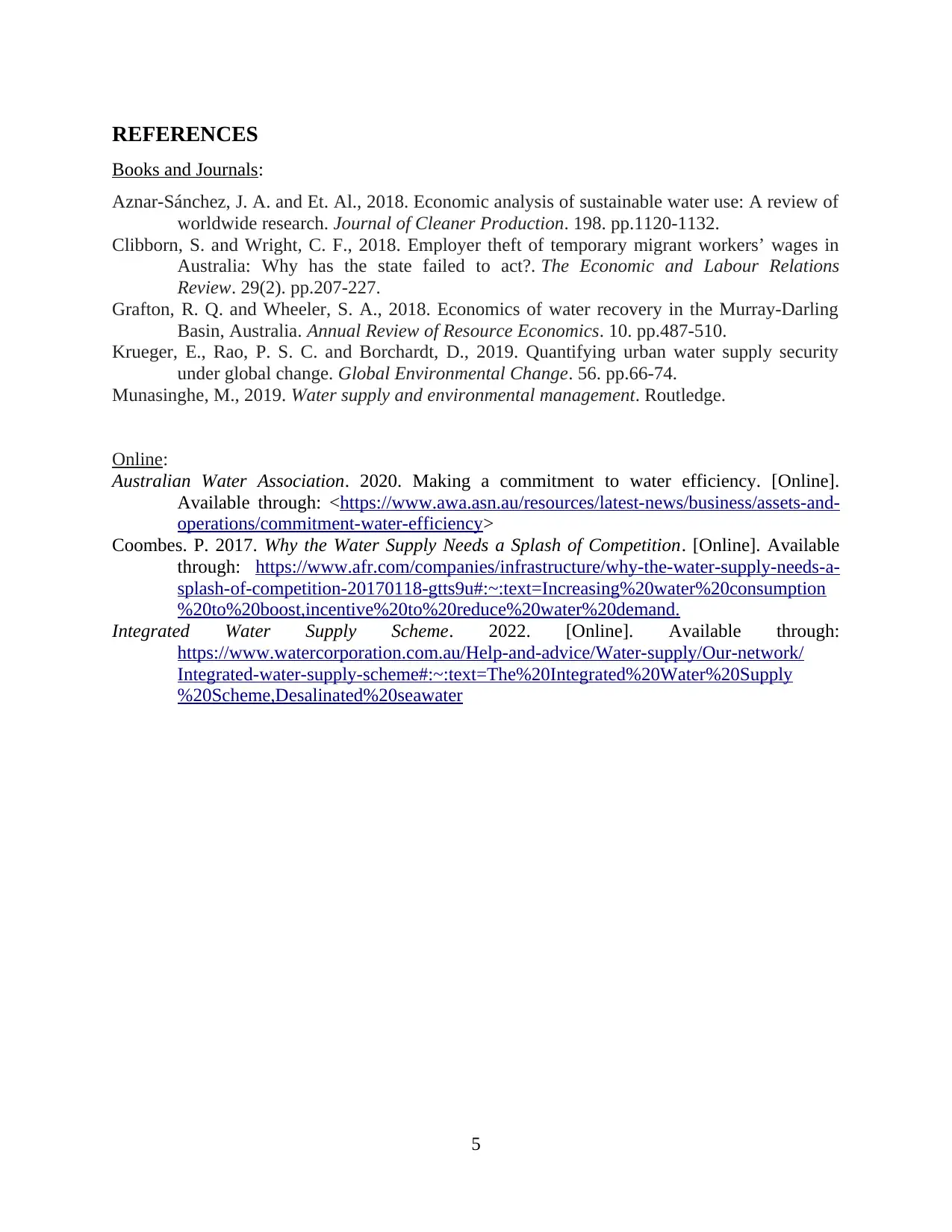
REFERENCES
Books and Journals:
Aznar-Sánchez, J. A. and Et. Al., 2018. Economic analysis of sustainable water use: A review of
worldwide research. Journal of Cleaner Production. 198. pp.1120-1132.
Clibborn, S. and Wright, C. F., 2018. Employer theft of temporary migrant workers’ wages in
Australia: Why has the state failed to act?. The Economic and Labour Relations
Review. 29(2). pp.207-227.
Grafton, R. Q. and Wheeler, S. A., 2018. Economics of water recovery in the Murray-Darling
Basin, Australia. Annual Review of Resource Economics. 10. pp.487-510.
Krueger, E., Rao, P. S. C. and Borchardt, D., 2019. Quantifying urban water supply security
under global change. Global Environmental Change. 56. pp.66-74.
Munasinghe, M., 2019. Water supply and environmental management. Routledge.
Online:
Australian Water Association. 2020. Making a commitment to water efficiency. [Online].
Available through: <https://www.awa.asn.au/resources/latest-news/business/assets-and-
operations/commitment-water-efficiency>
Coombes. P. 2017. Why the Water Supply Needs a Splash of Competition. [Online]. Available
through: https://www.afr.com/companies/infrastructure/why-the-water-supply-needs-a-
splash-of-competition-20170118-gtts9u#:~:text=Increasing%20water%20consumption
%20to%20boost,incentive%20to%20reduce%20water%20demand.
Integrated Water Supply Scheme. 2022. [Online]. Available through:
https://www.watercorporation.com.au/Help-and-advice/Water-supply/Our-network/
Integrated-water-supply-scheme#:~:text=The%20Integrated%20Water%20Supply
%20Scheme,Desalinated%20seawater
5
Books and Journals:
Aznar-Sánchez, J. A. and Et. Al., 2018. Economic analysis of sustainable water use: A review of
worldwide research. Journal of Cleaner Production. 198. pp.1120-1132.
Clibborn, S. and Wright, C. F., 2018. Employer theft of temporary migrant workers’ wages in
Australia: Why has the state failed to act?. The Economic and Labour Relations
Review. 29(2). pp.207-227.
Grafton, R. Q. and Wheeler, S. A., 2018. Economics of water recovery in the Murray-Darling
Basin, Australia. Annual Review of Resource Economics. 10. pp.487-510.
Krueger, E., Rao, P. S. C. and Borchardt, D., 2019. Quantifying urban water supply security
under global change. Global Environmental Change. 56. pp.66-74.
Munasinghe, M., 2019. Water supply and environmental management. Routledge.
Online:
Australian Water Association. 2020. Making a commitment to water efficiency. [Online].
Available through: <https://www.awa.asn.au/resources/latest-news/business/assets-and-
operations/commitment-water-efficiency>
Coombes. P. 2017. Why the Water Supply Needs a Splash of Competition. [Online]. Available
through: https://www.afr.com/companies/infrastructure/why-the-water-supply-needs-a-
splash-of-competition-20170118-gtts9u#:~:text=Increasing%20water%20consumption
%20to%20boost,incentive%20to%20reduce%20water%20demand.
Integrated Water Supply Scheme. 2022. [Online]. Available through:
https://www.watercorporation.com.au/Help-and-advice/Water-supply/Our-network/
Integrated-water-supply-scheme#:~:text=The%20Integrated%20Water%20Supply
%20Scheme,Desalinated%20seawater
5
1 out of 8
Related Documents
Your All-in-One AI-Powered Toolkit for Academic Success.
+13062052269
info@desklib.com
Available 24*7 on WhatsApp / Email
![[object Object]](/_next/static/media/star-bottom.7253800d.svg)
Unlock your academic potential
© 2024 | Zucol Services PVT LTD | All rights reserved.





